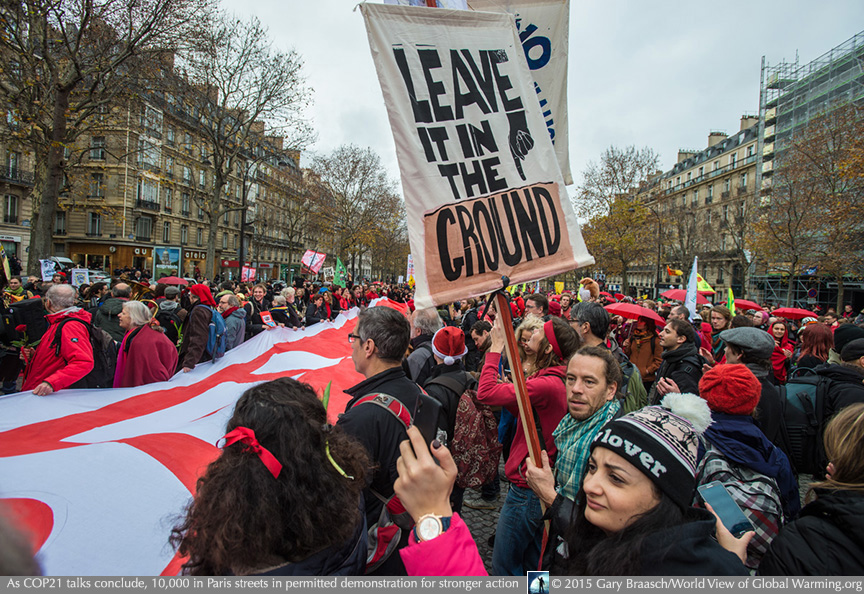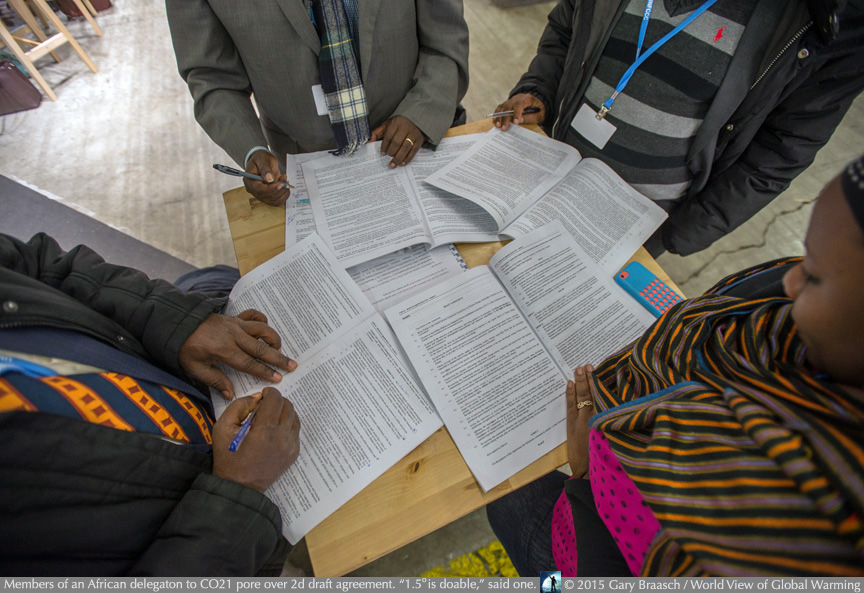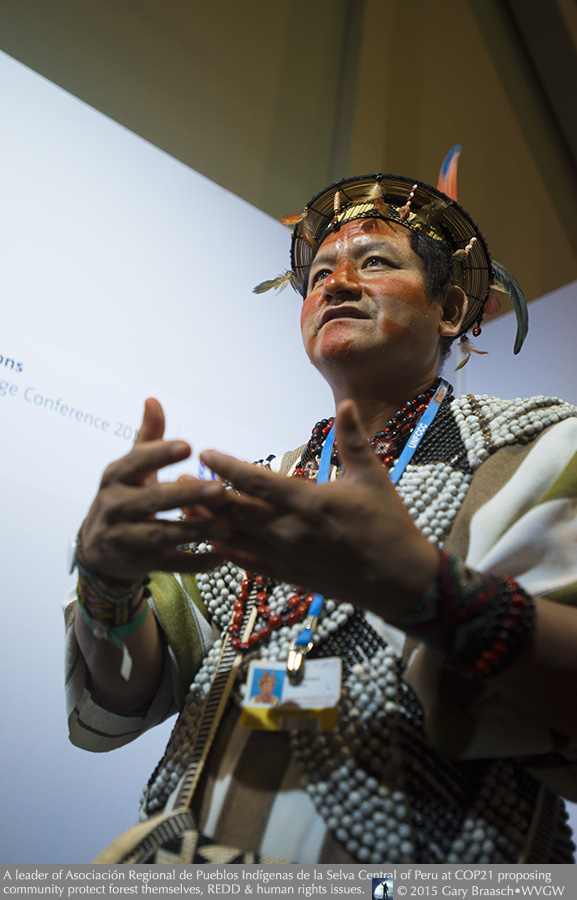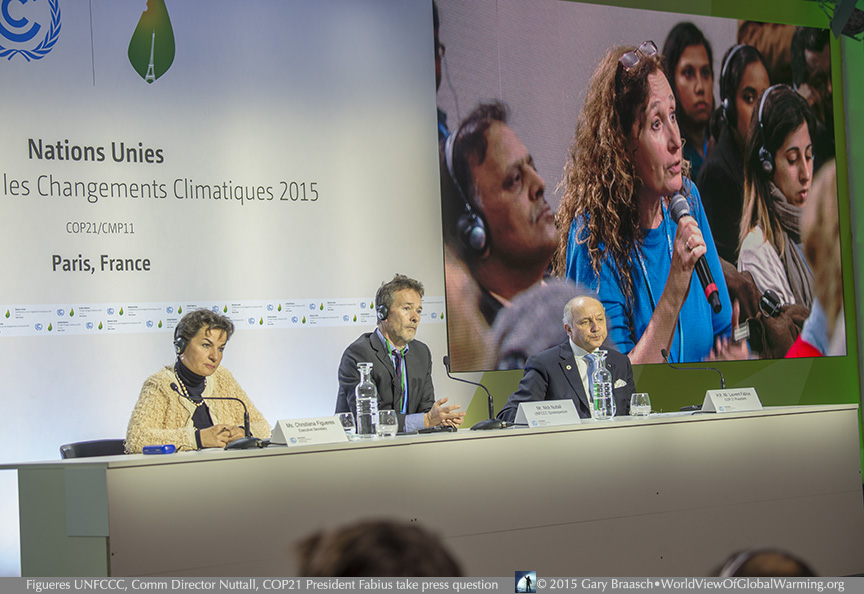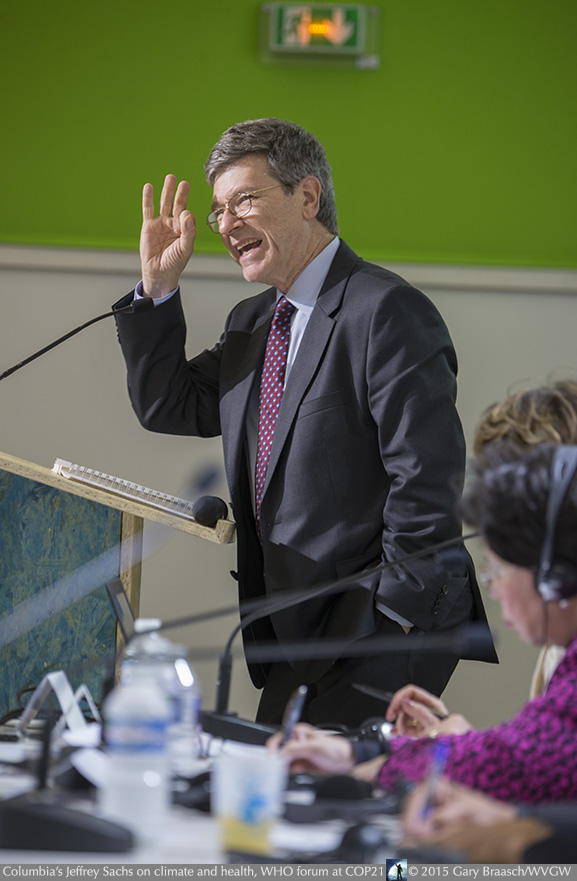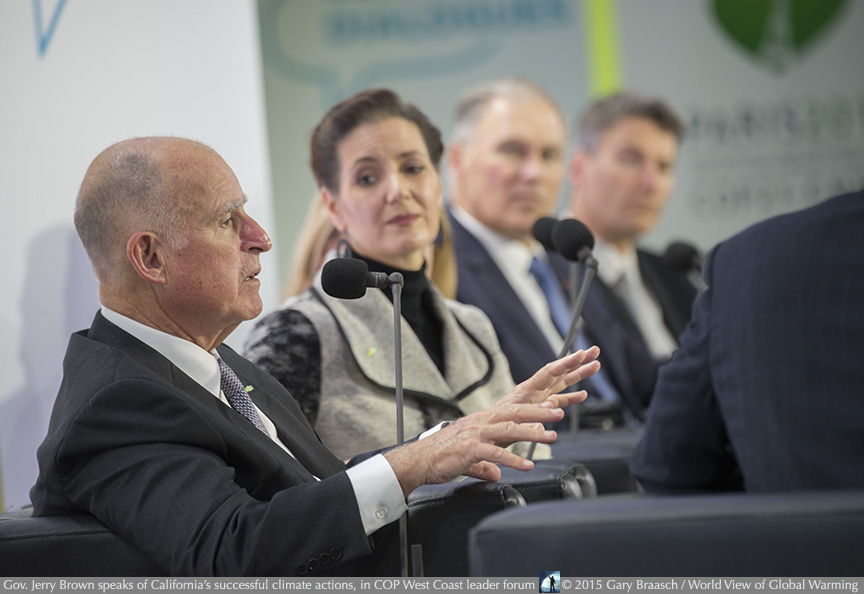World View of Global Warming is at the UN climate negotiations, the COP21, which began November 30 in Paris and concluded with an historic agreement to finally take international action to limit global warming. I wrote in my book in 2007, “Creating a safer, cleaner—and cooler—world. This is the direction for change. The world’s nations will recognize in global warming a common danger to their people, their cultures, and the Earth that supports them all.” The nations have finally reached that point — and now the incredibly important and difficult work of making that transition begins. .
Climate Photo of the Week
Paris climate talks produce an historic agreement in which all nations will sharply limit emissions to control global warming. As final negotiations were proceeding, thousands of citizens in Paris marched near Arc de Triomphe to urge an even stronger agreement.
For more photos from COP21 and associated events in Paris, please see
COP21 Photos 8 | 7 | 6 | 5 | 4 | 3 | 2 | 1
There was history in the climate negotiations and liberty in the streets of Paris, as the UN Climate Convention agreed for the first time December 12 to set an international goal to actively limit global warming, and Parisians and climate activists from around the world marched in the first approved public demonstration since the November 13 terror attacks.
The climate agreement binds the nations of the climate convention to “hold the increase in the global average temperature to well below 2°C above pre-industrial levels and to pursue efforts to limit the temperature increase to 1.5 °C.” This will finally set all nations on a path set in international law to sharply limit global warming pollution and its effects, the reason for the climate convention since its inception in 1992 in Rio. The agreement requires nations to individually lower their climate emissions, recognizes the vastly differing wealth of nations and also the damage from climate disruption which each is suffering, and sets in motion further procedures for funding energy change away from fossil fuels and the costs of adapting to increasing climate effects. Many of the provisions are non-binding and will require further negotiations and stronger wording to reach the temperature limits and protect millions from increasing climate disasters..
.
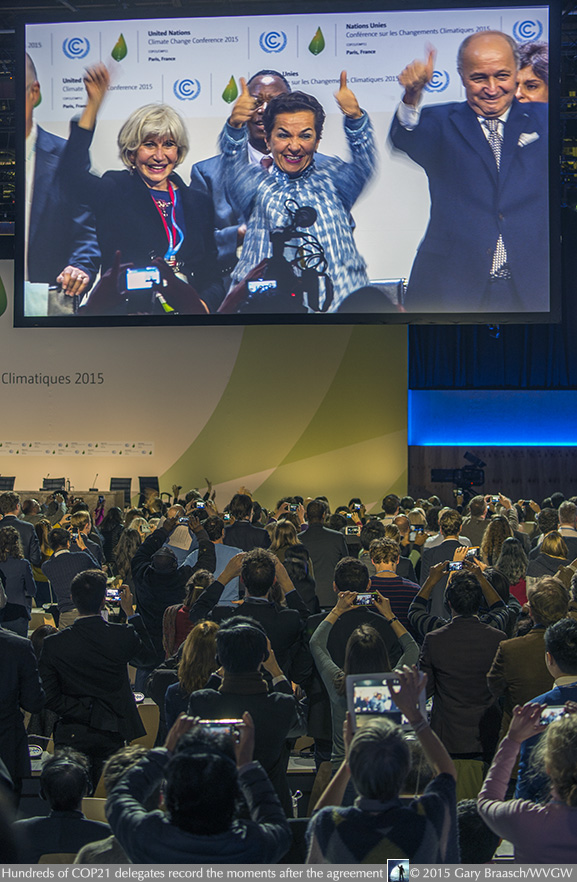
Ministers and staff members of the 195 signatories to the UN Convention on Climate Change — along with many NGO and media representatives — cheered and clapped for minutes as the full COP accepted the 31 page document, The Paris Agreement, late Saturday night. Negotiators had been working nearly around the clock since a near-final draft was released Thursday to get consensus on all provisions of the document, including financing the energy transition, increasing and verifying the specific actions of all nations to limit carbon emissions, and recognizing and paying for irreversible losses and damage from climate change effects. The agreement contains 20 pages of comments and decisions, which usually lead to action by the convention but do not become part of international law, and 11 pages of the actual agreement, which does carry legal weight.
The Paris Agreement is truly historic: This is the first time all members of the United Nations have agreed to control global warming pollution and keep the planet from warming uncontrollably. The UN Framework Convention on Climate Change (UNFCCC) of 1992 did not contain any binding rules or procedures for the nations to cooperate on controlling greenhouse gases. Huge differences between the developed world whose wealth is due to burning fossil fuels since the 18th century, and the developing nations only a few of which have recently begun to industrialize, have paralyzed many of the yearly meetings of the UNFCCC. After the Kyoto Protocol requiring only 42 nations to limit emissions failed to staunch the rising greenhouse gas flood, the COP in Copenhagen in 2009 said that the goal should be limiting world temperature rise to 2 degrees C above the pre-industrial level. Last year in Lima every nation agreed to make an emission reduction plan, and the stage was set for the Paris negotiations. Even before the talks began here on November 30, the 187 national emission reduction plans that have been written and are on record with the United Nations was a landmark achievement. If completed they reduce warming from the 4 to 6 degrees of no-action, but still mean an estimated 3.5 degrees C increase above pre-industrial temperatures. The details of these plans, the national targets, are not included in the agreement, although it requires “ambition” and “progression over time” toward stronger emissions limits.
The major success of this agreement is solidifying in international law that nations must follow their emissions reduction plans (called INDCs in the pact), and try to improve them, so the unrelenting increase of greenhouse gases in the atmosphere will begin to abate, keeping the temperature below the 2 degree mark. Island nations like Tuvalu, the Marshall Islands and Caribbean countries have lobbied for years that sea level rise and increasing storms argued for an even lower level — and the agreement is a victory for getting that 1.5 degrees in writing as at least an aspirational goal.
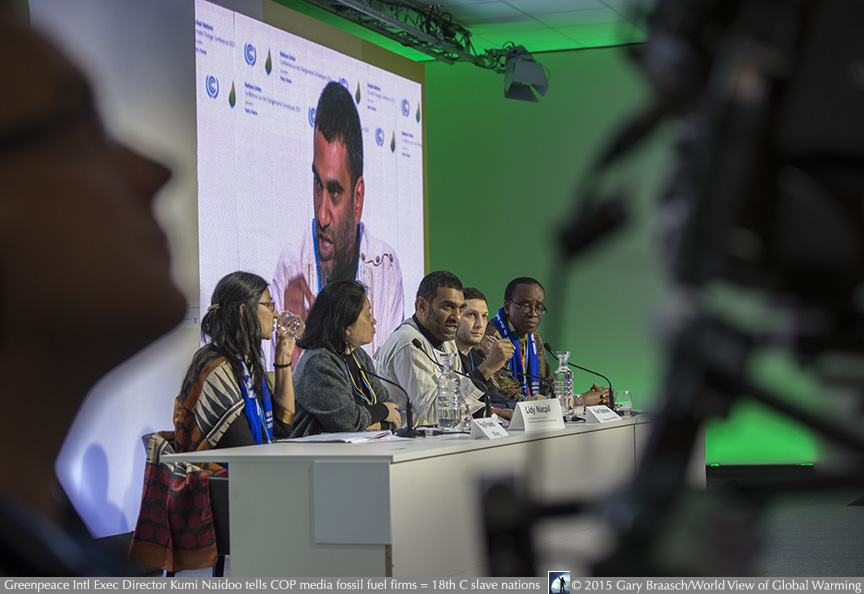
Although recognition of gender issues in climate, the special plight of small and island nations and the special knowledge of indigenous communities remained in the text, advocates were dismayed by the removal of mention of human rights in the core final agreement. Ben Schachter, a human rights officer with the UN High Commision on Human Rights, said they were concerned because it is important "that states are honoring their commitment to respect human rights for all people.” Other human rights and environmental advocates denounced the agreement for making the goal of 1.5 degrees only as something to “pursue,” not the actual target, for lack of specifics about immediate reduction in climate emissions rather than waiting for 2020, and for what they saw as weak and conflicted wordings about finance and loss and damage. The call of many national leaders, most developing nations and environmental observers for a clear, comprehensive, fair and binding agreement that moves the world rapidly toward a one hundred percent renewable energy future by early in the second half of this century, was not met by the Paris Agreement. But its general goals and inclusion of every nation have never been seen in an international climate agreement before.
Previously we reported:
Many indigenous communities sent representatives to Paris to be part of their national delegations and to lobby strongly for local control, a free flow of funds and technology to help them, and an stop to industrialized logging, mining and oil extraction which have destroyed native lands and added much to the global load of carbon the atmosphere. An important issue for these groups and many women’s spokespeople at the COP was payment for loss and damage from rapid climate changes. This is a subject that has been discussed in previous meetings for decades, but never resolved. Compensation to people and nations harmed by irreversible and permanent harm can be simple insurance, but inevitably brings up legal liability and reparations — which major climate negotiations nations steadfastly reject. The COP21 agreement will keep to the work plan from the Warsaw COP two years ago, which is to study loss and damage but not to address it until COP 22.
The French leadership of the COP — Conference of the 195 Parties, the signatory nations of the UN Climate Convention -- divided the talks into eight topics in order to keep them going and meet the Friday deadline. The most divisive issues were, not surprisingly, who should pay whom and how much for the costs of energy switching and adapting to effects and damages caused by global warming, what each nation should actually do to reduce emissions and if actions will be mandatory, and how soon the agreement would take effect and how often actions would be measured and adjusted. Drafts of the agreement through the two weeks were continuous strings of bracketed options which had to be worked out among nations with often conflicting needs, especially those countries dependent on or major suppliers of, fossil fuels versus small island states. Behind the scenes reports said that many small meetings among groups of nations were called by Laurent Fabius, president of the COP, through night-long negotiations as the deadline of Friday 11 December neared. Drafts were issued late on Thursday, and again on Friday as the final meeting of the COP was delayed until Saturday. One final delay was over wording that developed nations "shall" set "economy-wide absolute emissions reduction targets" for cutting their greenhouse gas pollution — wording that in international law would trigger Congressional approval of the Agreement. Knowing that Congress is not likely to do anything positive about climate change, Secretary of State Kerry and staff worked for hours to convince other nations to change the word to “should.” But this also weakens the agreement in an area of action that must be strengthened by many countries for the 2 degree limit to be reached.
Myriad citizen and lobby groups in hundreds of press conferences, forums, demonstrations and exhibits around the official meeting place and throughout Paris warned that without an ambitious, compreshensive, fair and binding international agreement, dire effects on health, women and children, low-lying nations, the disadvantaged, native communities and biodiversity will increase to a deadly pace. Strong effects on all of these and more from the current one degree of human-caused warming and carbon dioxide emissions are already scientifically documented. In a meeting sponsored by the World Health Organization, Columbia University’s Dr. Jeffrey Sachs referred to a the record air pollution in Beijing: “The timing of the red alert in China this week is a red alert for the whole planet … we’ve gone too far.”
The concept of climate justice is mentioned only once in the active part of the draft Paris agreement, in the section about how carbon emission cuts would be done. Human rights, the right to health, land rights of indigenous cultures, and food security, are mentioned mostly in the preamble to the agreement, which recognizes issues but is not binding. Gender and indigenous cultures get some mention in the active text. Climate justice was a major topic in side meetings and press conferences by a wide span of interests from business groups to native culture individuals. Many people from forested regions were advocating various forms of forest protection to cut pollution, sequester carbon and harbor biodiversity (called REDD in convention language), and some opposed any continuation of forest “management” by corporations and industrialized nations.
Many other side meetings at the COP celebrated the solutions to rapid climate change already being undertaken around the world. A major outcome of the Lima COP one year ago was an initiative to highlight and encourage advances in new and clean energy, carbon pricing, actions by cities, states and companies — who are not waiting for an international agreement. The first day of the COP, with Obama and President Hollande of France, Bill Gates announced a multi-billion dollar fund for accelerated clean energy development and deployment. Renewable and clean energy to carry out the needs of the world for health, climate and fairness was being put forward in many studies and reports, in advance of the climate meeting.
Much more to come as this crucial agreement is analyzed and the nations move forward. World View of Global Warming will be photographing and reporting on this great transition.
COP21 Photos 8 | 7 | 6 | 5 | 4 | 3 | 2 | 1
COP21, UN climate negotiations, Paris, Nov-Dec 2015
COP21, the Paris Climate Talks, December 4, 2015
COP21, the Paris Climate Talks, December 8, 2015
COP21, the Paris Climate Talks, December 9, 2015
COP21, the Paris Climate Talks, December 12, 2015
COP21, the Paris Climate Talks, December 13, 2015
15 years of World View of Global Warming, documenting climate change 1999-2015
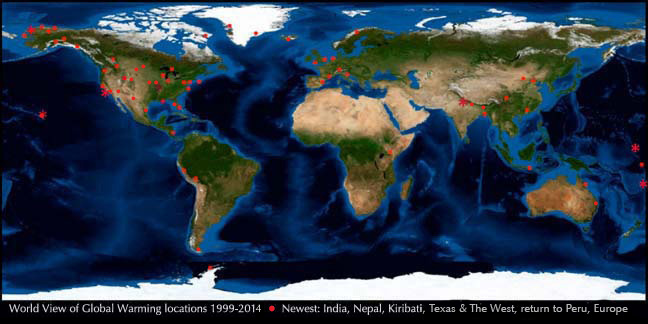
This project would be impossible without scientists and observers around the world who have provided hundreds of scientific contacts and papers. See Background, Advisors, and Reference for documentation, funders and major advisors, without whom I could not complete the work.
World View of Global Warming is a project of the Blue Earth Alliance, Seattle Washington, a 501(c)3 tax-exempt organization. The project is supported entirely by donations, grants, and license fees for the photographs. Please see information about how to contribute.
For other information about Gary Braasch's climate change projects and books, please see the books Earth Under Fire and How We Know What We Know About Our Changing Climate, and the exhibit "Climate Change in Our World" at the Books and Exhibits link on the top menu of this page.
COPYRIGHT NOTICE:
Photography and text Copyright © 2005 - 2017 (and before) Gary Braasch All rights reserved. Use of photographs in any manner without permission is prohibited by US copyright law. Photography is available for license to publications and other uses. Please contact requestinformation@worldviewofglobalwarming.org. View more of Gary Braasch's photography here.



